Impact of Nanolayered Material and Nanohybrid Modifications on Their Potential Antibacterial Activity
Abstract
:1. Introduction
2. Materials and Methods
2.1. Preparation of Nanolayered Structures and Nanohybrids
2.2. Characterization Techniques
2.3. Bacterial Strain
2.4. Microbiological Media
2.5. Nutrient Agar (OXOID, England)
2.6. Diagnostic Sensitivity Test Agar Medium (D.S.T. Agar) (HIMEDIA, Thane West, India)
2.7. Antimicrobial Inhibitory Test (Agar Diffusion Method)
3. Results
3.1. Inhibitory Effect of Different Modified Al/Zn Nanolayered Structures
3.2. Effect of Ultrasonic Technique on the Inhibitory Effect of the Nanolayered Structures Al/Zn
3.3. Effect of Carbon Nanotubes on the Inhibitory Effect of the Nanolayered Structures Al/Zn
3.4. Effect of Nanohybrids on the Inhibitory Effect of Al/Zn Nanolayered Structures
4. Discussion
5. Conclusions
Author Contributions
Funding
Institutional Review Board Statement
Informed Consent Statement
Data Availability Statement
Acknowledgments
Conflicts of Interest
References
- Li, Q.; Mahendra, S.; Lyon, D.Y.; Brunet, L.; Liga, M.V.; Li, D.; Alvarez, P.J. Antimicrobial nanomaterials for water disinfection and microbial control: Potential applications and implications. Water Res. 2008, 42, 4591–4602. [Google Scholar] [CrossRef] [PubMed]
- Vahabi, K.; Mansoori, G.; Karimi, S. Biosynthesis of Silver Nanoparticles by Fungus Trichoderma Reesei (A Route for Large-Scale Production of AgNPs). Insci. J. 2011, 1, 65–79. [Google Scholar] [CrossRef]
- Elmi, F.; Alinezhad, H.; Moulana, Z.; Salehian, F.; Mohseni Tavakkoli, S.; Asgharpour, F.; Fallah, H.; Elmi, M.M. The use of antibacterial activity of ZnO nanoparticles in the treatment of municipal wastewater. Water Sci. Technol. 2014, 70, 763–770. [Google Scholar] [CrossRef]
- Lu, H.; Wang, J.; Stoller, M.; Wang, T.; Bao, Y.; Hao, H. An overview of nanomaterials for water and wastewater treatment. Adv. Mater. Sci. Eng. 2016, 2016, 4964828. [Google Scholar] [CrossRef] [Green Version]
- Saber, O.; Shaalan, N.M.; Ahmed, F.; Kumar, S.; Alshoaibi, A. One-Step Multi-Doping Process for Producing Effective Zinc Oxide Nanofibers to Remove Industrial Pollutants Using Sunlight. Crystals 2021, 11, 1268. [Google Scholar] [CrossRef]
- Ramos, M.A.D.S.; de Toledo, L.G.; Spósito, L.; Marena, G.D.; de Lima, L.C.; Fortunato, G.C.; Araújo, V.H.S.; Bauab, T.M.; Chorilli, M. Nanotechnology-based lipid systems applied to resistant bacterial control: A review of their use in the past two decades. Int. J. Pharm. 2021, 603, 120706. [Google Scholar] [CrossRef]
- Wang, C.; Ma, X.; Hu, J.; Tian, X.; Zhang, H.; Dong, D.; Fang, Z.; Lyu, M.; Wang, S.; Lu, J. Nanolayered Double Hydroxide Inhibits the Pathogenicity of Vibrio parahaemolyticus. J. Nanomater. 2021, 2021, 4945670. [Google Scholar] [CrossRef]
- Yang, Q.; Cui, P.; Liu, C.; Fang, G.; Huang, M.; Wang, Q.; Zhou, Y.; Hou, H.; Wang, Y. In situ stabilization of the adsorbed Co2+ and Ni2+ in rice straw biochar based on LDH and its reutilization in the activation of peroxymonosulfate. J. Hazard. Mater. 2021, 416, 126215. [Google Scholar] [CrossRef] [PubMed]
- Johnston, A.-L.; Lester, E.; Williams, O.; Gomes, R.L. Understanding Layered Double Hydroxide properties as sorbent materials for removing organic pollutants from environmental waters. J. Environ. Chem. Eng. 2021, 9, 105197. [Google Scholar] [CrossRef]
- Chatterjee, A.; Bharadiya, P.; Hansora, D. Layered double hydroxide based bionanocomposites. Appl. Clay Sci. 2019, 177, 19–36. [Google Scholar] [CrossRef]
- León-Vallejo, A.M.; Velázquez-Herrera, F.D.; Sampieri, Á.; Landeta-Cortés, G.; Fetter, G. Study of layered double hydroxides as bactericidal materials against Corynebacterium ammoniagenes, a bacterium responsible for producing bad odors from human urine and skin infections. Appl. Clay Sci. 2019, 180, 105194. [Google Scholar] [CrossRef]
- Mishra, G.; Dash, B.; Pandey, S. Layered double hydroxides: A brief review from fundamentals to application as evolving biomaterials. Appl. Clay Sci. 2018, 153, 172–186. [Google Scholar] [CrossRef]
- Bi, X.; Zhang, H.; Dou, L. Layered Double Hydroxide-Based Nanocarriers for Drug Delivery. Pharmaceutics 2014, 6, 298–332. [Google Scholar] [CrossRef]
- Mallakpour, S.; Hatami, M.; Hussain, C.M. Recent innovations in functionalized layered double hydroxides: Fabrication, characterization, and industrial applications. Adv. Colloid Interface Sci. 2020, 283, 102216. [Google Scholar] [CrossRef] [PubMed]
- Costantino, U.; Leroux, F.; Nocchetti, M.; Mousty, C. Chapter 6—LDH in Physical, Chemical, Biochemical, and Life Sciences. In Developments in Clay Science; Bergaya, F., Lagaly, G., Eds.; Elsevier: Amsterdam, The Netherlands, 2013; Volume 5, pp. 765–791. [Google Scholar] [CrossRef]
- Lv, L.; Yang, Z.; Chen, K.; Wang, C.; Xiong, Y. 2D layered double hydroxides for oxygen evolution reaction: From fundamental design to application. Adv. Energy Mater. 2019, 9, 1803358. [Google Scholar] [CrossRef]
- Tang, Z.; Qiu, Z.; Lu, S.; Shi, X. Functionalized layered double hydroxide applied to heavy metal ions absorption: A review. Nanotechnol. Rev. 2020, 9, 800–819. [Google Scholar] [CrossRef]
- Tabish, M.; Yasin, G.; Anjum, M.J.; Malik, M.U.; Zhao, J.; Yang, Q.; Manzoor, S.; Murtaza, H.; Khan, W.Q. Reviewing the current status of layered double hydroxide-based smart nanocontainers for corrosion inhibiting applications. J. Mater. Res. Technol. 2021, 10, 390–421. [Google Scholar] [CrossRef]
- Kamal, W.; El Rouby, W.M.; El-Gendy, A.O.; Farghali, A.A. Bimodal applications of LDH-chitosan nanocomposite: Water treatment and antimicrobial activity. In IOP Conference Series: Materials Science and Engineering; IOP Publishing: Bristol, UK, 2018; Volume 464, p. 012005. [Google Scholar]
- Cheng, H.M.; Gao, X.W.; Zhang, K.; Wang, X.R.; Zhou, W.; Li, S.J.; Cao, X.L.; Yan, D.P. A novel antimicrobial composite: ZnAl-hydrotalcite with p-hydroxybenzoic acid intercalation and its possible application as a food packaging material. New J. Chem. 2019, 43, 19408–19414. [Google Scholar] [CrossRef]
- Djebbi, M.A.; Bouaziz, Z.; Elabed, A.; Sadiki, M.; Elabed, S.; Namour, P.; Jaffrezic-Renault, N.; Amara, A.B.H. Preparation and optimization of a drug delivery system based on berberine chloride-immobilized MgAl hydrotalcite. Int. J. Pharm. 2016, 506, 438–448. [Google Scholar] [CrossRef]
- Vajedi, F.S.; Dehghani, H.; Zarrabi, A. Design and characterization of a novel pH-sensitive biocompatible and multifunctional nanocarrier for in vitro paclitaxel release. Mater. Sci. Eng. C 2021, 119, 111627. [Google Scholar] [CrossRef]
- Li, X.; Gong, P.; Li, Y.; Yu, J.; Wang, F.; Li, X.; Fan, Z.; Wang, Z. Double-carrier drug delivery system based on polyurethane-polyvinyl alcohol/layered double hydroxide nanocomposite hydrogel. Mater. Lett. 2019, 243, 1–4. [Google Scholar] [CrossRef]
- Abdel Moaty, S.A.; Farghali, A.A.; Khaled, R. Preparation, characterization and antimicrobial applications of Zn-Fe LDH against MRSA. Mater. Sci. Eng. C 2016, 68, 184–193. [Google Scholar] [CrossRef]
- Li, M.; Sultanbawa, Y.; Xu, Z.P.; Gu, W.; Chen, W.; Liu, J.; Qian, G. High and long-term antibacterial activity against Escherichia coli via synergy between the antibiotic penicillin G and its carrier ZnAl layered double hydroxide. Colloids Surf. B Biointerfaces 2019, 174, 435–442. [Google Scholar] [CrossRef] [PubMed]
- Olivera, S.; Hu, C.; Nagananda, G.S.; Reddy, N.; Venkatesh, K.; Muralidhara, H.B. Multipurpose composite for heavy metal sorption, antimicrobial, and antioxidant applications. Int. J. Environ. Sci. Technol. 2018, 16, 2017–2030. [Google Scholar] [CrossRef]
- Mallakpour, S.; Dinari, M.; Hatami, M. Novel nanocomposites of poly(vinyl alcohol) and Mg–Al layered double hydroxide intercalated with diacid N-tetrabromophthaloyl-aspartic. J. Therm. Anal. 2015, 120, 1293–1302. [Google Scholar] [CrossRef]
- Baruah, A.; Mondal, S.; Sahoo, L.; Gautam, U.K. Ni-Fe-layered double hydroxide/N-doped graphene oxide nanocomposite for the highly efficient removal of Pb (II) and Cd (II) ions from water. J. Solid State Chem. 2019, 280, 120963. [Google Scholar] [CrossRef]
- Liu, S.-Q.; Li, S.-P.; Li, X.-D. Intercalation of methotrexatum into layered double hydroxides via exfoliation-reassembly process. Appl. Surf. Sci. 2015, 330, 253–261. [Google Scholar] [CrossRef]
- Sanati, S.; Rezvani, Z. Ultrasound-assisted synthesis of NiFe-layered double hydroxides as efficient electrode materials in supercapacitors. Ultrason. Sonochem. 2018, 48, 199–206. [Google Scholar] [CrossRef]
- Althabaiti, N.S.; Al-Nwaiser, F.M.; Saleh, T.S.; Mokhtar, M. Ultrasonic-assisted Michael addition of arylhalide to activated olefins utilizing nanosized CoMgAl-layered double hydroxide catalysts. Catalysts 2020, 10, 220. [Google Scholar] [CrossRef] [Green Version]
- Bauer, A.W.; Kirby, W.M.M.; Sherris, J.C.; Turck, M. t19661 Antibiotic susceptibility testing by a standardized single disk method. Am. J. Clin. Pathol. 1966, 45, 493–496. [Google Scholar] [CrossRef]
- Wang, J.; Zhang, L.; Zhang, T.; Du, T.; Li, T.; Yue, T.; Li, Z.; Wang, J. Selective removal of heavy metal ions in aqueous solutions by sulfide-selector intercalated layered double hydroxide adsorbent. J. Mater. Sci. Technol. 2019, 35, 1809–1816. [Google Scholar] [CrossRef]
- Cardinale, A.M.; Carbone, C.; Consani, S.; Fortunato, M.; Parodi, N. Layered Double Hydroxides for Remediation of Industrial Wastewater from a Galvanic Plant. Crystals 2020, 10, 443. [Google Scholar] [CrossRef]
- Faille, C.; Jullien, C.; Fontaine, F.; Bellon-Fontaine, M.N.; Slomianny, C.; Benezech, T. Adhesion of Bacillus spores and Escherichia coli cells to inert surfaces: Role of surface hydrophobicity. Can. J. Microbiol. 2002, 48, 728–738. [Google Scholar] [CrossRef]
- Youssef, A.M.; Moustafa, H.A.; Barhoum, A.; Hakim, A.E.-F.A.A.; Dufresne, A. Evaluation of the Morphological, Electrical and Antibacterial Properties of Polyaniline Nanocomposite Based on Zn/Al-Layered Double Hydroxides. ChemistrySelect 2017, 2, 8553–8566. [Google Scholar] [CrossRef]
- Gorzin, F.; Abadi, M.B.R. Adsorption of Cr(VI) from aqueous solution by adsorbent prepared from paper mill sludge: Kinetics and thermodynamics studies. Adsorpt. Sci. Technol. 2018, 36, 149–169. [Google Scholar] [CrossRef]
- Madhavi, A.; Srinivasulu, M.; Chandra, M.S.; Rangaswamy, V. Detoxification of Heavy Metals Using Marine Metal Resistant Bacteria: A New Method for the Bioremediation of Contaminated Alkaline Environments. In Innovations in Biotechnology for a Sustainable Future; Springer: Cham, Switzerland, 2021; pp. 297–332. [Google Scholar]
- Acrylamide, O.C. National Primary Drinking Water Regulations. Kidney; United States Environmental Protection Agency: Washington, DC, USA, 2009; Volume 2, pp. 1–7.
- EPA. National Primary Drinking Water Regulations. 2022. Available online: https://www.epa.gov/ground-water-and-drinking-water/national-primary-drinking-water-regulations (accessed on 16 February 2022).
- AlMulla, A.A.A. Understanding the Impacts of Changing Soil Temperature, Water Irrigation Source and Fertiliser Types on C and N Cycling in Arid Soils; Bangor University: Bangor, UK, 2016. [Google Scholar]
- Rajaitha, P.; Hajra, S.; Sahu, M.; Mistewicz, K.; Toroń, B.; Abolhassani, R.; Panda, S.; Mishra, Y.; Kim, H. Unraveling highly efficient nanomaterial photocatalyst for pollutant removal: A comprehensive review and future progress. Mater. Today Chem. 2021, 23, 100692. [Google Scholar] [CrossRef]
- Gómez-López, P.; Puente-Santiago, A.; Castro-Beltrán, A.; do Nascimento, L.A.S.; Balu, A.M.; Luque, R.; Alvarado-Beltrán, C.G. Nanomaterials and catalysis for green chemistry. Curr. Opin. Green Sustain. Chem. 2020, 24, 48–55. [Google Scholar] [CrossRef]
- Liang, X.-J.; Kumar, A.; Shi, D.; Cui, D. Nanostructures for medicine and pharmaceuticals. J. Nanomater. 2012, 2012, 921897. [Google Scholar] [CrossRef]
- Patil, T.V.; Patel, D.K.; Dutta, S.D.; Ganguly, K.; Randhawa, A.; Lim, K.-T. Carbon Nanotubes-Based Hydrogels for Bacterial Eradiation and Wound-Healing Applications. Appl. Sci. 2021, 11, 9550. [Google Scholar] [CrossRef]
- Smith, S.C.; Rodrigues, D.F. Carbon-based nanomaterials for removal of chemical and biological contaminants from water: A review of mechanisms and applications. Carbon 2015, 91, 122–143. [Google Scholar] [CrossRef]
- Rajavel, K.; Gomathi, R.; Manian, S.; Rajendra Kumar, R.T. In Vitro Bacterial Cytotoxicity of CNTs: Reactive Oxygen Species Mediate Cell Damage Edges over Direct Physical Puncturing. Langmuir 2014, 30, 592–601. [Google Scholar] [CrossRef] [PubMed]
- Yick, S.; Mai-Prochnow, A.; Levchenko, I.; Fang, J.; Bull, M.K.; Bradbury, M.; Murphy, A.B.; Ostrikov, K.K. The effects of plasma treatment on bacterial biofilm formation on vertically-aligned carbon nanotube arrays. RSC Adv. 2015, 5, 5142–5148. [Google Scholar] [CrossRef] [Green Version]
- Zhu, B.; Xia, X.; Xia, N.; Zhang, S.; Guo, X. Modification of fatty acids in membranes of bacteria: Implication for an adaptive mechanism to the toxicity of carbon nanotubes. Environ. Sci. Technol. 2014, 48, 4086–4095. [Google Scholar] [CrossRef] [PubMed]
- Yin, Y.; Ni, P.; Liu, D.; Yang, S.; Almeida, A.; Guo, Q.; Zhang, Z.; Deng, L.; Wang, D. Bacteriophage potential against Vibrio parahaemolyticus biofilms. Food Control 2019, 98, 156–163. [Google Scholar] [CrossRef]
- Malek, I.; Schaber, C.F.; Heinlein, T.; Schneider, J.J.; Gorb, S.N.; Schmitz, R.A. Vertically aligned multi walled carbon nanotubes prevent biofilm formation of medically relevant bacteria. J. Mater. Chem. B 2016, 4, 5228–52355. [Google Scholar] [CrossRef] [PubMed] [Green Version]
- Dong, X.; Yang, L. Inhibitory effects of single-walled carbon nanotubes on biofilm formation from Bacillus anthracis spores. Biofouling 2014, 30, 1165–1174. [Google Scholar] [CrossRef]
- Li, M.; Xu, Z.P.; Sultanbawa, Y.; Chen, W.; Liu, J.; Qian, G. Potent and durable antibacterial activity of ZnO-dotted nanohybrids hydrothermally derived from Zn Al-layered double hydroxides. Colloids Surf. B Biointerfaces 2019, 181, 585–592. [Google Scholar] [CrossRef]
- Freeman, B.A.; Crapo, J.D. Biology of disease: Free radicals and tissue injury, Laboratory Investigation. J. Tech. Methods Pathol. 1982, 47, 412–426. [Google Scholar]
- Sugarman, B. Zinc and infection. Rev. Infect. Dis. 1983, 5, 137–147. [Google Scholar] [CrossRef]
- Awassa, J.; Cornu, D.; Soulé, S.; Carteret, C.; Ruby, C.; El-Kirat-Chatel, S. Divalent metal release and antimicrobial effects of layered double hydroxides. Appl. Clay Sci. 2021, 216, 106369. [Google Scholar] [CrossRef]
- Peng, F.; Wang, D.; Zhang, D.; Cao, H.; Liu, X. The prospect of layered double hydroxide as bone implants: A study of mechanical properties, cytocompatibility and antibacterial activity. Appl. Clay Sci. 2018, 165, 179–187. [Google Scholar] [CrossRef]
- Dutt, M.A.; Hanif, M.A.; Nadeem, F.; Bhatti, H.N. A review of advances in engineered composite materials popular for wastewater treatment. J. Environ. Chem. Eng. 2020, 8, 104073. [Google Scholar] [CrossRef]
- Díez-Pascual, A.M. State of the Art in the Antibacterial and Antiviral Applications of Carbon-Based Polymeric Nanocomposites. Int. J. Mol. Sci. 2021, 22, 10511. [Google Scholar] [CrossRef] [PubMed]
- Chen, M.; Sun, Y.; Liang, J.; Zeng, G.; Li, Z.; Tang, L.; Zhu, Y.; Jiang, D.; Song, B. Understanding the influence of carbon nanomaterials on microbial communities. Environ. Int. 2019, 126, 690–698. [Google Scholar] [CrossRef] [PubMed]
- Maleki Dizaj, S.; Mennati, A.; Jafari, S.; Khezri, K.; Adibkia, K. Antimicrobial activity of carbon-based nanoparticles. Adv. Pharm. Bull. 2015, 5, 19–23. [Google Scholar]
- Martynková, G.S.; Valášková, M. Antimicrobial Nanocomposites Based on Natural Modified Materials: A Review of Carbons and Clays. J. Nanosci. Nanotechnol. 2014, 14, 673–693. [Google Scholar] [CrossRef]
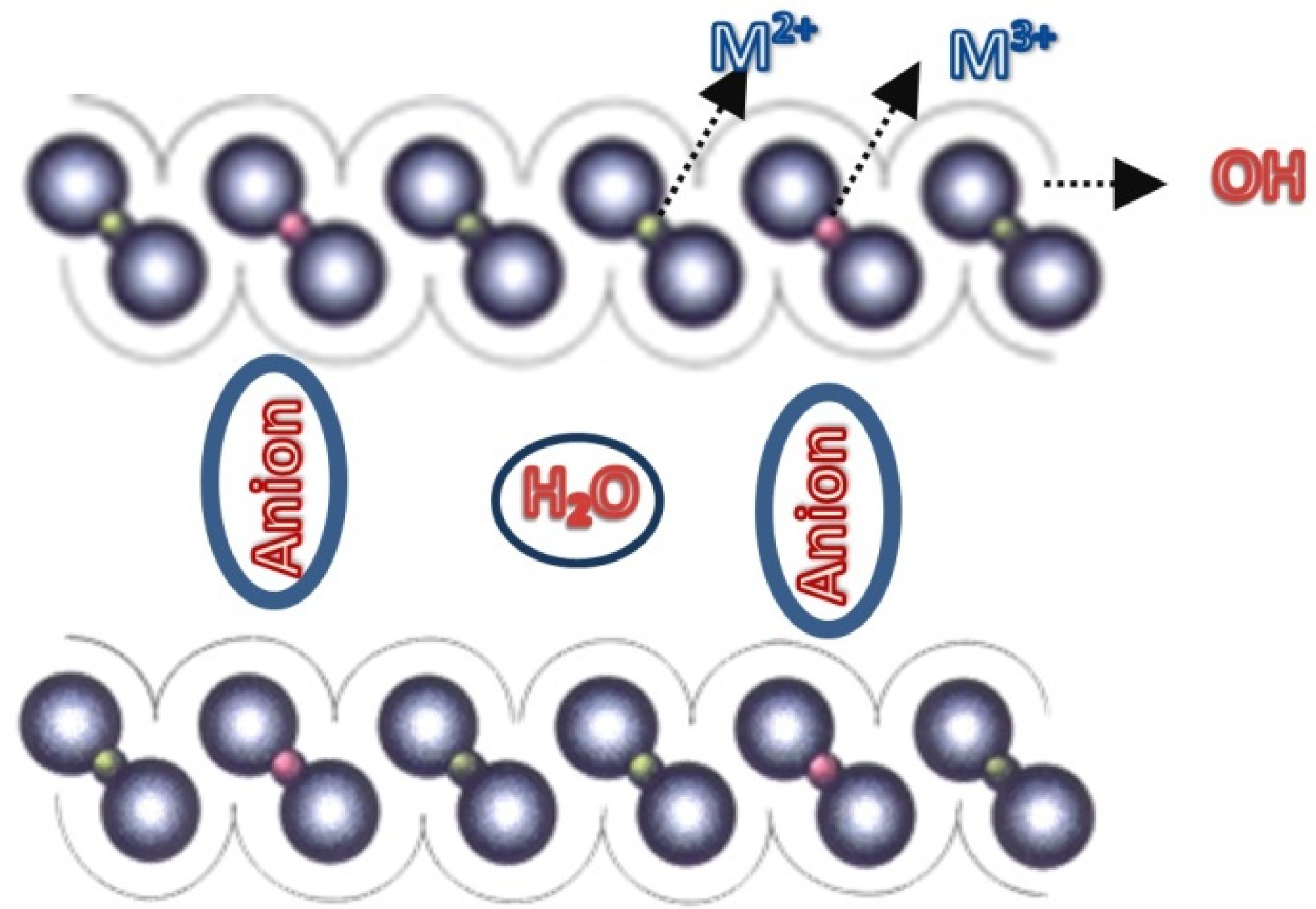

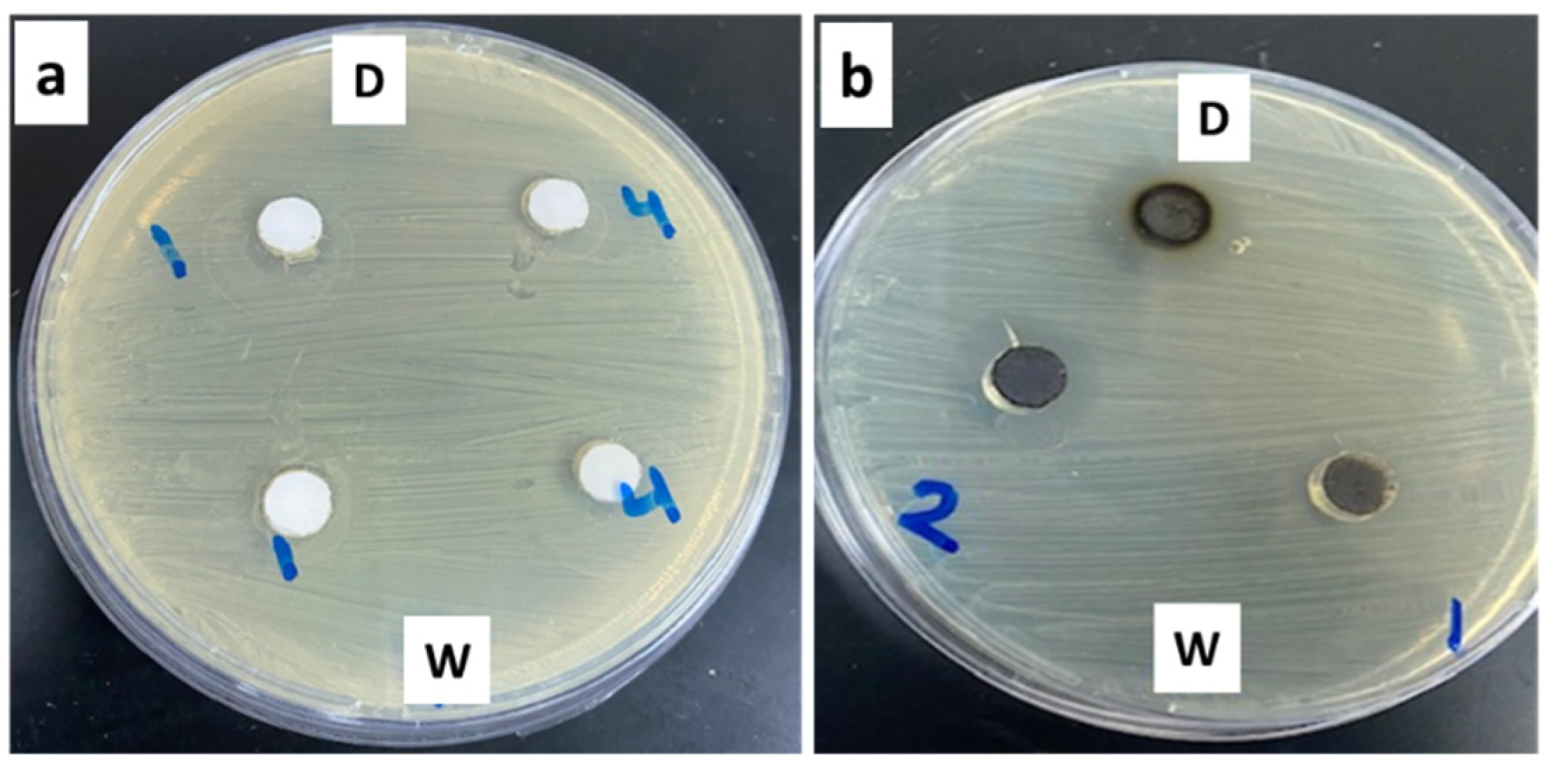
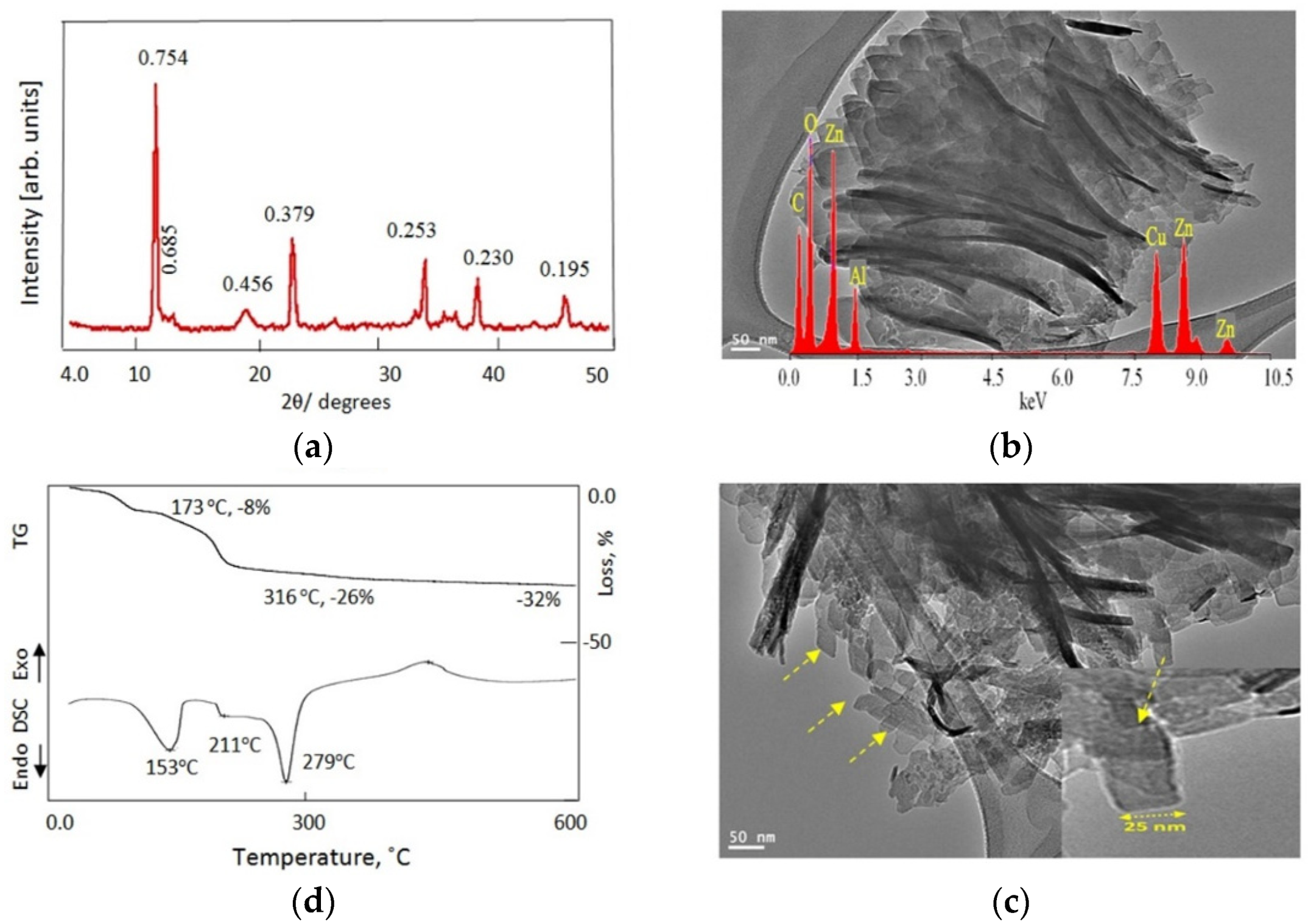
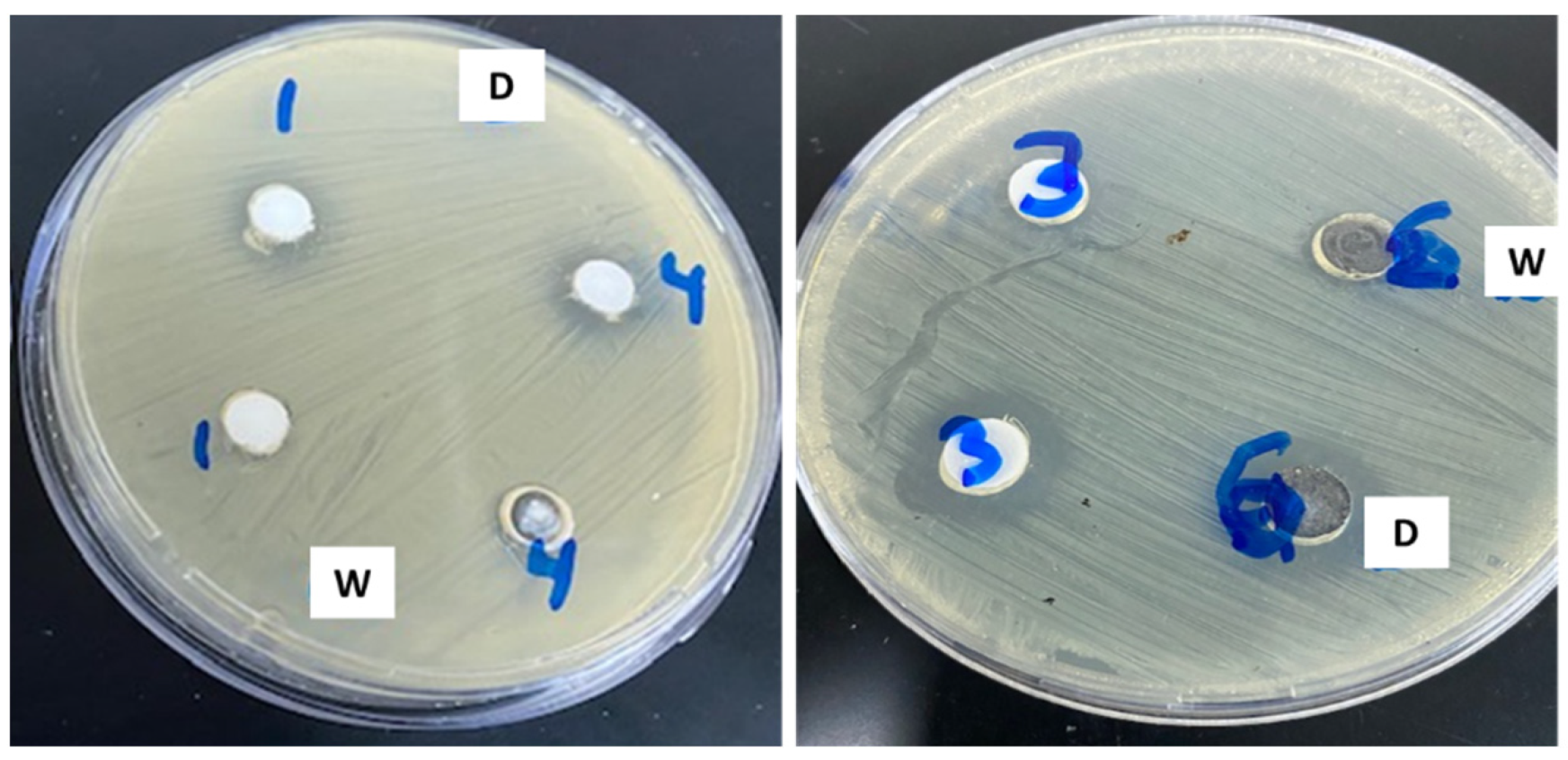

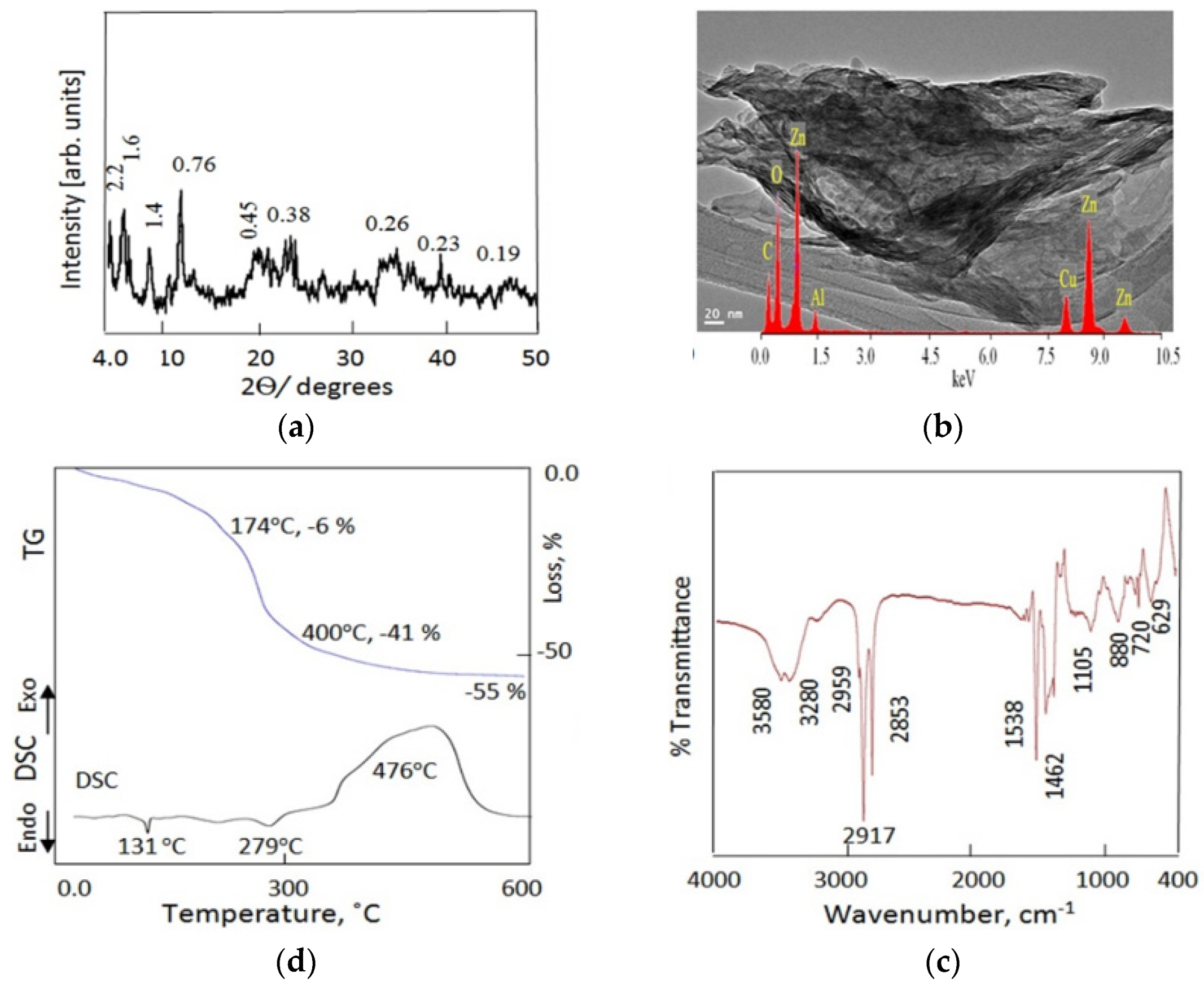
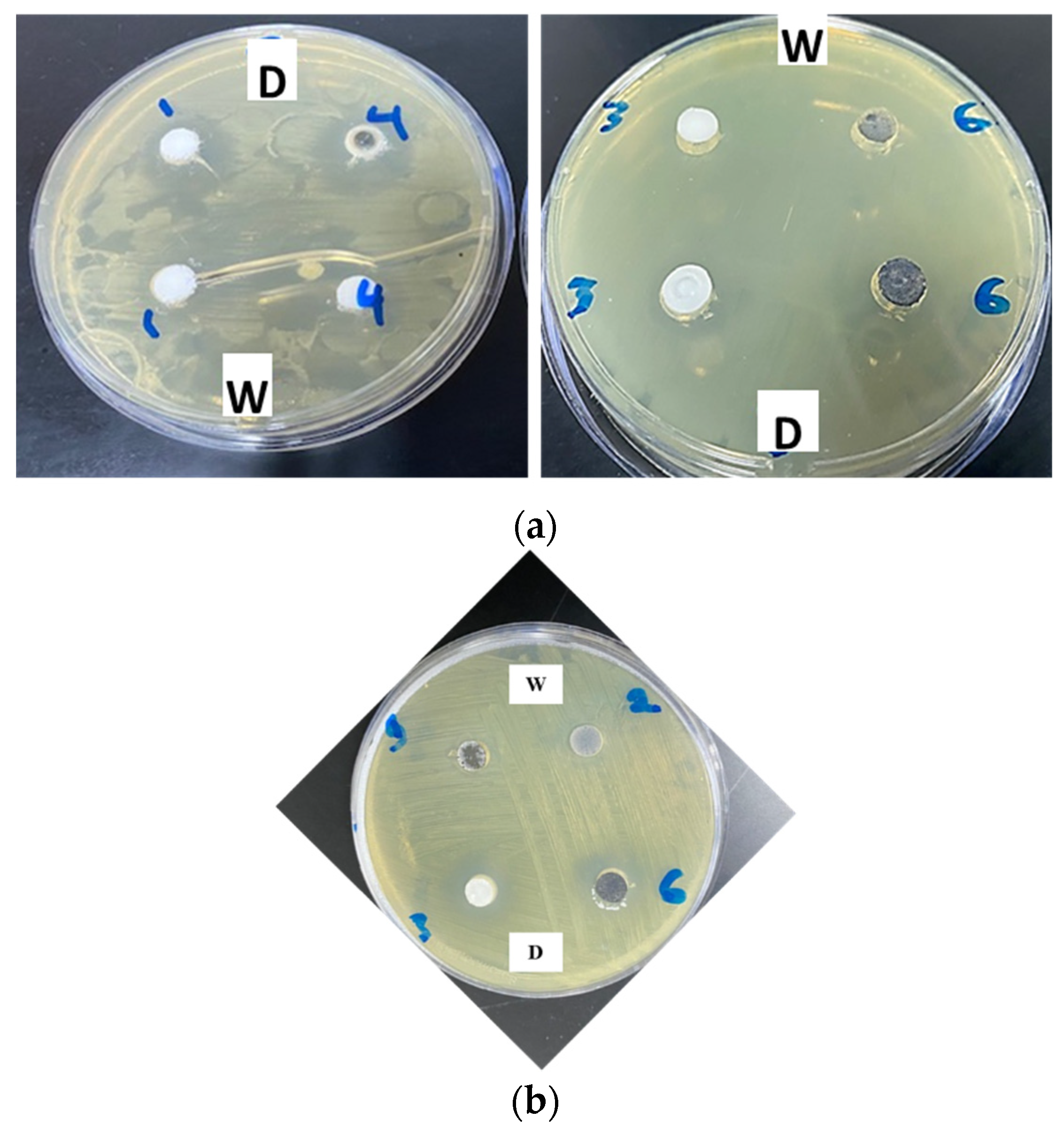
| Samples | Nanolayered Structures | Nanohybrids | d-Spacing |
|---|---|---|---|
| ZA-1 | √ | × | 0.760 nm |
| ZA-2 | √ | × | 0.760 nm |
| ZA-3 | √ | × | 0.754 nm |
| ZA-4 | √ | √ | 0.750 nm and 0.681 nm |
| ZA-5 | √ | √ | 2.2 nm, 1.6 nm and 1.4 nm |
| Table | Diameter of Inhibition Zone (mm) | |||
|---|---|---|---|---|
| Sample ZA-1 | Sample ZA-2 | |||
| D | W | D | W | |
| K. pneumonae-1 | 8.1 | NA | NA | NA |
| S. aureus | NA | NA | 7.3 | 7 |
| E. coli | 8.5 | NA | 11.3 | 10 |
| P. aeruginosa | 15 | NA | NA | NA |
| Types of Bacteria | Diameter of Inhibition Zone (mm) | |||
|---|---|---|---|---|
| Sample ZA-1 | Sample ZA-3 | |||
| D | W | D | W | |
| K. pneumonae-1 | 7.5 | NA | 14.6 | NA |
| S. aureus | NA | NA | NA | NA |
| E. coli | 8.5 | NA | 18.5 | NA |
| P. aeruginosa | 15 | NA | 11.5 | NA |
| Types of Bacteria | Diameter of Inhibition Zone (mm) | |||
|---|---|---|---|---|
| Sample ZA-1 | Sample ZA-4 | |||
| D | W | D | W | |
| K. pneumonae-1 | 7.5 | NA | 8.4 | NA |
| S. aureus | NA | NA | 7.5 | 8.7 |
| E. coli | 8.5 | NA | 7.7 | 7 |
| P. aeruginosa | 15 | NA | 16.5 | NA |
| Types of Bacteria | Diameter of Inhibition Zone (mm) | |||
|---|---|---|---|---|
| Sample ZA-1 | Sample ZA-5 | |||
| D | W | D | W | |
| K. pneumonae-1 | 7.5 | NA | 12.5 | NA |
| S. aureus | NA | NA | NA | NA |
| E. coli | 8.5 | NA | 16.7 | NA |
| P. aeruginosa | 15 | NA | 13.7 | NA |
Publisher’s Note: MDPI stays neutral with regard to jurisdictional claims in published maps and institutional affiliations. |
© 2022 by the authors. Licensee MDPI, Basel, Switzerland. This article is an open access article distributed under the terms and conditions of the Creative Commons Attribution (CC BY) license (https://creativecommons.org/licenses/by/4.0/).
Share and Cite
Alali, H.A.; Saber, O.; Berekaa, M.M.; Osama, D.; Ezzeldin, M.F.; Shaalan, N.M.; AlMulla, A.A. Impact of Nanolayered Material and Nanohybrid Modifications on Their Potential Antibacterial Activity. Nanomaterials 2022, 12, 2749. https://doi.org/10.3390/nano12162749
Alali HA, Saber O, Berekaa MM, Osama D, Ezzeldin MF, Shaalan NM, AlMulla AA. Impact of Nanolayered Material and Nanohybrid Modifications on Their Potential Antibacterial Activity. Nanomaterials. 2022; 12(16):2749. https://doi.org/10.3390/nano12162749
Chicago/Turabian StyleAlali, Hasna Abdullah, Osama Saber, Mahmoud Mohamed Berekaa, Doaa Osama, Mohamed Farouk Ezzeldin, Nagih M. Shaalan, and Abdulaziz Abdulrahman AlMulla. 2022. "Impact of Nanolayered Material and Nanohybrid Modifications on Their Potential Antibacterial Activity" Nanomaterials 12, no. 16: 2749. https://doi.org/10.3390/nano12162749







